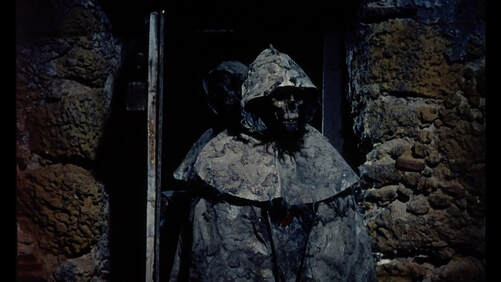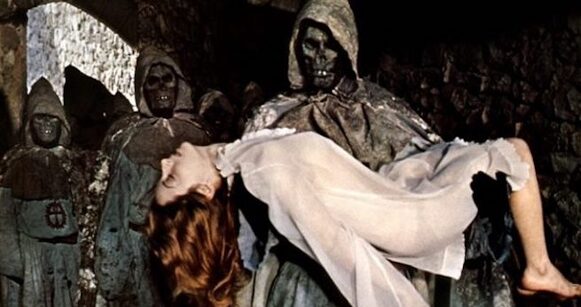 On the border between Spain and Portugal lie the ruins of Berzano, a medieval town long since abandoned by the living. Its only inhabitants now are the Templars, put to death for their sins but still rising at night as the living dead. As their eyes were pecked out by birds during their time on the gallows, the undead Templars cannot see. But they can hear, and they keep an ear out for anyone who strolls too close to the ruins at night... ...This is the premise of Tombs of the Blind Dead, the seminal 1972 film by Spanish director Amando de Ossorio. The movie has a reputation as the Iberian answer to Night of the Living Dead, and indeed, the influence of George A. Romero's film is clear – particularly in the sequence where the corpse of a woman bitten to death by the Templars gets up and rampages through a mortuary. But the film also has roots in an older tradition. Romero made a concerted effort to avoid Gothic trappings in his zombie film, but Tombs of the Blind Dead embraces the imagery of crumbling ruins, centuries-old curses and supernatural revenants. These elements are all put to good effect: the scenes of skeletal Templars rising from their tombs and pacing through an authentic medieval monastery, their sinister chants echoing on the soundtrack as they mount their shrouded horses, are unforgettable. There is all the material for a true Gothic classic on offer, but unfortunately, the sequences of eerie medieval horror end up clashing with the sun-bleached and deeply 1970s milieu that surrounds them. Admittedly, the film's modern setting does offer a few inspired touches – most notably the scenes set in a mannequin workshop, where trendy shop dummies and their assorted plastic members are used to compose bizarre establishing shots, or end up as surreal collateral damage during the zombie-burning action. But other sequences are just incongruous: the requisite protagonists-learn-about-sinister-legends-from-frightened-locals scene, familiar from so many Dracula retellings, strikes an awkward note when set in a landscape of flares and plastic lawn chairs. It falls upon the film's characters to bridge the gap between cobwebbed Gothic and sideburned grooviness. After the three protagonists get a desperately unpromising introductory scene at a swimming pool, the film manages to deploy an intriguing spot of characterization. One of the two heroines, Virginia (Maria Elena Arpon), is a lesbian who had a fling with her old school friend Betty (Lone Fleming). But Betty has since shacked up with her new boyfriend, Roger (Cesar Burner), leaving Virginia feeling left out as they travel together. But then Virginia is killed by the Templars at the end of the first act, allowing the comparatively boring Betty and Roger to take center stage. They are soon joined by a pair of detectives investigating the mysterious deaths – as though any horror film has ever been improved by the introduction of men in suits droning out rational explanations for the supernatural horrors we've just seen. Towards the end of the film we have the dubious honor of meeting rapist Pedro (Jose Thelman) and his sociopathic girlfriend Nina (Veronica Llimera), who end up alongside Betty and Roger in the middle of the ruins when the Templars return once more. This leads to some enjoyably silly material like Betty and Nina having a cat-fight while Roger pounds on a door begging them to let him inside; but the climax does manage a few genuinely arresting moments as well. One tense scene has Betty trying to remain silent, so that the sightless Templars don't notice her – only for the loud beating of her heart to give her away. Much of Tombs of the Blind Dead is gleefully salacious. The film includes a medieval flashback where the still-living Templars take a captured peasant woman, strip her to her oddly disco-chic underclothes, and proceed to ride in circles lashing at her flash with swords. The sequence manages to be both utterly unconvincing and genuinely horrible, concluding with close-ups of the Templars' bearded faces lapping at the girl's wounds. While this kind of thing may have been titillating in 1972, it has not aged well at all. Still, the high Gothic sequences with the undead Templars are truly timeless. We can pick a few holes – those skeletal hands reaching from the tombs could have done with a little more articulation, for one – but it's easier just to sit back and enjoy the atmosphere. At the very least stick around for the ending, which tries to one-up the famously nihilistic conclusion to Night of the Living Dead. While it doesn't quite achieve that goal, the final sequence does offer an inventive way for the creepy skeletons to come out firmly on top – just as they deserve. Currently, you can stream Tombs of the Blind Dead on Amazon Prime. By Doris V. Sutherland
0 Comments
Leave a Reply. |
Archives
March 2023
|

 RSS Feed
RSS Feed